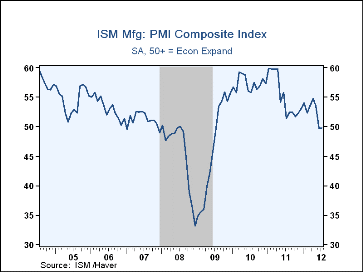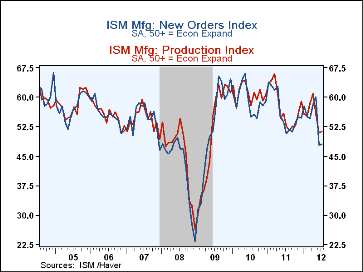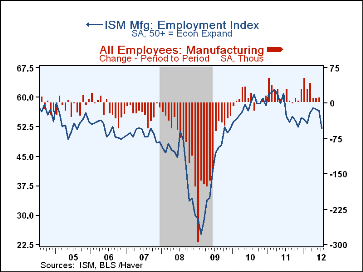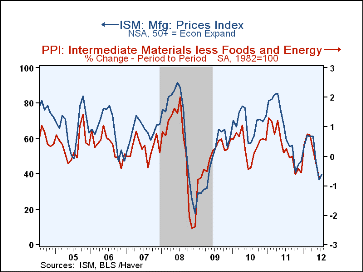 Global| Aug 01 2012
Global| Aug 01 2012U.S. ISM Factory Index Remains Depressed
by:Tom Moeller
|in:Economy in Brief
Summary
Activity in the industrial sector continues to struggle. The July ISM Composite Index of industrial sector activity ticked up to 49.8 versus an unrevised 49.7 in June. The figure compared to Consensus expectations for 50.0 and remains [...]
Activity in the industrial sector continues to struggle. The July ISM Composite Index of industrial sector activity ticked up to 49.8 versus an unrevised 49.7 in June. The figure compared to Consensus expectations for 50.0 and remains the worst since the recession's end. During the last ten years there has been an 80% correlation between the index level and the three-month change in factory sector production.
A decline in the employment component to 52.0 from 56.6 accounted for the greatest weakness in last month's composite. During the last ten years there's been an 88% correlation between the level of the index and the m/m change in factory sector payrolls. Most other components were little changed m/m except inventories which rose to their highest level since March. New orders and production both ticked up but remained near the recovery low. The export orders index, at 46.5, was down m/m and compared to the February high of 59.5.
The price index rose slightly to 39.5 but remained near its lowest since April 2009. Eleven percent of firms raised prices while 32 percent lowered them. During the last ten years there has been an 83% correlation between the index and the m/m change in the core intermediate producer price index.
The separate index of new export orders fell sharply to 47.5, its lowest since the recession's end. The imports series was steady at 53.5.
The figures from the Institute For Supply Management (ISM) are diffusion indexes and can be found in Haver's USECON database. The expectations data are in the AS1REPNA database.
| ISM Mfg | Jul | Jun | May | Jul'11 | 2011 | 2010 | 2009 |
|---|---|---|---|---|---|---|---|
| Composite Index | 49.8 | 49.7 | 53.5 | 51.4 | 55.2 | 57.3 | 46.4 |
| New Orders | 48.0 | 47.8 | 60.1 | 50.8 | 56.4 | 59.2 | 52.0 |
| Production | 51.3 | 51.0 | 55.6 | 52.5 | 57.4 | 61.0 | 50.8 |
| Employment | 52.0 | 56.6 | 56.9 | 55.1 | 57.4 | 57.3 | 40.7 |
| Supplier Deliveries | 48.7 | 48.9 | 48.7 | 50.6 | 54.7 | 58.1 | 51.6 |
| Inventories | 49.0 | 44.0 | 46.0 | 48.0 | 50.1 | 50.8 | 37.1 |
| Prices Paid Index (NSA) | 39.5 | 37.0 | 47.5 | 59.0 | 65.2 | 68.9 | 48.3 |
Tom Moeller
AuthorMore in Author Profile »Prior to joining Haver Analytics in 2000, Mr. Moeller worked as the Economist at Chancellor Capital Management from 1985 to 1999. There, he developed comprehensive economic forecasts and interpreted economic data for equity and fixed income portfolio managers. Also at Chancellor, Mr. Moeller worked as an equity analyst and was responsible for researching and rating companies in the economically sensitive automobile and housing industries for investment in Chancellor’s equity portfolio. Prior to joining Chancellor, Mr. Moeller was an Economist at Citibank from 1979 to 1984. He also analyzed pricing behavior in the metals industry for the Council on Wage and Price Stability in Washington, D.C. In 1999, Mr. Moeller received the award for most accurate forecast from the Forecasters' Club of New York. From 1990 to 1992 he was President of the New York Association for Business Economists. Mr. Moeller earned an M.B.A. in Finance from Fordham University, where he graduated in 1987. He holds a Bachelor of Arts in Economics from George Washington University.










